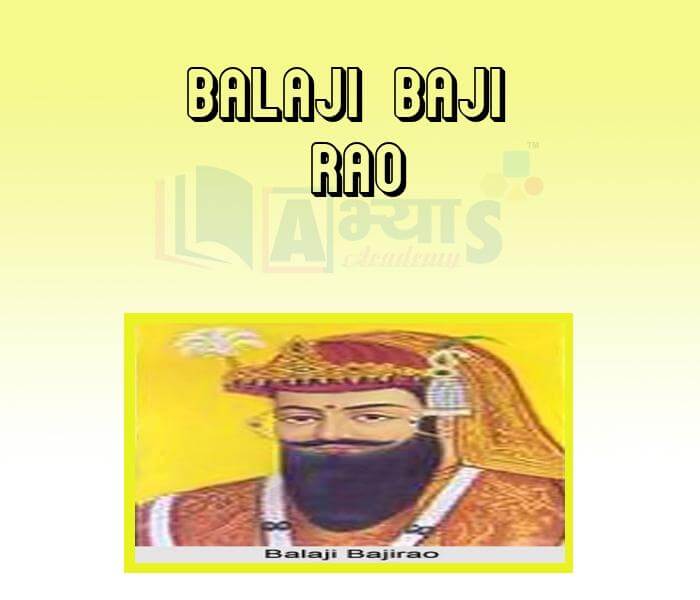Balaji Baji Rao












Balaji Baji Rao
Balaji Baji Rao (1740-1760 CE): Shrimant Peshwa Balaji Bajirao Bhat, also known as Nana Saheb, was the 8th Peshwa of the Maratha Empire in India. He was appointed as Peshwa in 1740 upon the death of his illustrious father, the Peshwa Bajirao I. During his tenure, the Chhatrapati was reduced to a mere figurehead.
The eldest son of Baji Rao I, Balaji Baji Rao, succeeded his father. In 1750 CE he made Pune his capital. Balaji Baji Rao captured Delhi in 1753 CE and Punjab in 1758 CE. The Marathas clashed with Abdali in the Third Battle of Panipat in 1761 CE. Neither the Sikhs nor the Rajput kingdoms helped the Marathas. The Marathas were routed; they never recovered fully from this defeat.
Expansion of the Maratha Empire: The empire expanded between 1720 and 1761. It slowly chipped away at the authority of the Mughal Empire. By the 1720s Malwa and Gujarat were seized from the Mughals. The Maratha king was recognized as the overlord of the entire Deccan peninsula by the 1730s. He had the right to levy chauth and sardeshmukhi in the entire region. After the raid in Delhi by the Marathas in 1737, the frontiers of the Maratha domination expanded fast:
Though these were not formally included in the Maratha empire, they were made to pay tribute as a way of accepting Maratha sovereignty.
Drawbacks of expansion: Though the expansion brought enormous wealth, it came at a price. It made other regional rulers hostile towards the Marathas. Consequently, they were not inclined to support the Marathas in the third battle of Panipat in 1761.
Administrative system of Marathas:
The Administration of the Marathas was very well organized. After the Maratha rule became secure subsequent to the conquests, revenue demands were gradually introduced taking local conditions into account. Agriculture was encouraged and trade got revived. This allowed the following Maratha chiefs enough resources to raise powerful armies:
The campaigns of Marathas into Malwa in the 1720s did not challenge the growth and prosperity of the cities of the region. Ujjain expanded under Sindhia’s patronage and Indore under that of Holkar. These cities were large and prosperous by all accounts and functioned as important commercial and cultural centres. New trade routes emerged within the areas that were controlled by the Marathas. The silk produced in the Chanderi region found a new outlet in the city of Poona. Burhanpur which had earlier participated in the trade between Agra and Surat now expanded its hinterland to include Poona and Nagpur in the south and, in the east, Lucknow and Allahabad.
What were the drawbacks of the Maratha expansion? | |||
| Right Option : C | |||
| View Explanation | |||
Name the Maratha chiefs who, with revival of trade, got enough resources to raise armies. | |||
| Right Option : A | |||
| View Explanation | |||
Who made Pune his capital in 1750 CE? | |||
| Right Option : B | |||
| View Explanation | |||
Students / Parents Reviews [10]
Being a parent, I saw my daughter improvement in her studies by seeing a good result in all day to day compititive exam TMO, NSO, IEO etc and as well as studies. I have got a fruitful result from my daughter.

Prisha Gupta
8thAbout Abhyas metholodology the teachers are very nice and hardworking toward students.The Centre Head Mrs Anu Sethi is also a brilliant teacher.Abhyas has taught me how to overcome problems and has always taken my doubts and suppoeted me.

Shreya Shrivastava
8thAbhyas is a complete education Institute. Here extreme care is taken by teacher with the help of regular exam. Extra classes also conducted by the institute, if the student is weak.

Om Umang
10thIt was a good experience with Abhyas Academy. I even faced problems in starting but slowly and steadily overcomed. Especially reasoning classes helped me a lot.

Cheshta
10thMy experience with Abhyas academy is very good. I did not think that my every subject coming here will be so strong. The main thing is that the online tests had made me learn here more things.

Hiya Gupta
8thIt was good as the experience because as we had come here we had been improved in a such envirnment created here.Extra is taught which is beneficial for future.

Eshan Arora
8thMy experience with Abhyas is very good. I have learnt many things here like vedic maths and reasoning also. Teachers here first take our doubts and then there are assignments to verify our weak points.

Shivam Rana
7thAbhyas Methodology is very good. It is based on according to student and each child manages accordingly to its properly. Methodology has improved the abilities of students to shine them in future.

Manish Kumar
10thIt has a great methodology. Students here can get analysis to their test quickly.We can learn easily through PPTs and the testing methods are good. We know that where we have to practice

Barkha Arora
10thMy experience was very good with Abhyas academy. I am studying here from 6th class and I am satisfied by its results in my life. I improved a lot here ahead of school syllabus.
